- Home
- slideshows
- miscellaneous
- The best stovetop espresso makers and moka pots
The best stovetop espresso makers and moka pots
The best stovetop espresso maker overall

The best for gas stoves
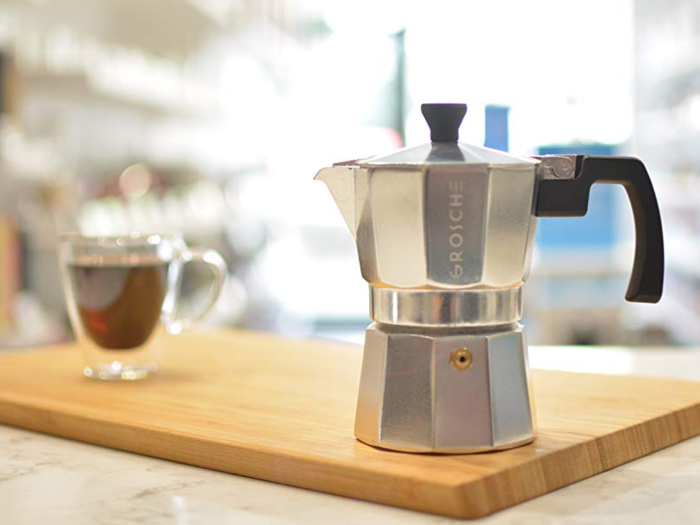
While Bialetti is a tried-and-true favorite coming up on its centennial anniversary, if you're anything like me or some other members of the Insider Picks team, you've probably burned through any number of them over the years. Not because the aluminum gave way, but that cheap, plastic handle the company has been attaching to their oh-so-iconic moka pot in recent history. While Bialetti used to make its pots with stainless steel handles, the new, markedly cheaper plastic handle does not survive the hands of hapless fools such as I.
So, after a third Bialetti handle melted on me this year (it's admittedly more a reflection on me and my ilk than Bialetti, which I still hold dearly), I decided to set out on a quest to find a somewhat more foolproof and final replacement.
Enter GROSCHE — The company eliminates the melting handle problem in two ways. One, the handle is farther from the unit and your stove burner, so it's not sitting directly over heat. Two, the handle is also made out of a soft rubber-coated heat-resistant plastic, so in case you do make the ill-advised decision to leave the kitchen with a burner on the stove going, you won't be out an espresso pot and $20 to replace it.
The Grosche comes in 3-, 6-, and 9-cup models, and is made out of aluminum.
Founded in 2006, Grosche is a newer company, but it's already won customers who've left applause on Amazon to the tune of: "Have worn out 6 or so well-loved Bialettis similar to this one."
Reviews left by 159 people average out to a respectable 4.2/5-star rating, and 73% of those reviews included 5-star ratings.
The cherry on top? Through the Safe Water Project, Grosche pledges to provide 50+ days of safe drinking water for people in need for every product they sell. — Owen Burke
Pros: Handle is heat-resistant, socially responsible company
Cons: None yet, at time of writing
The best expensive option
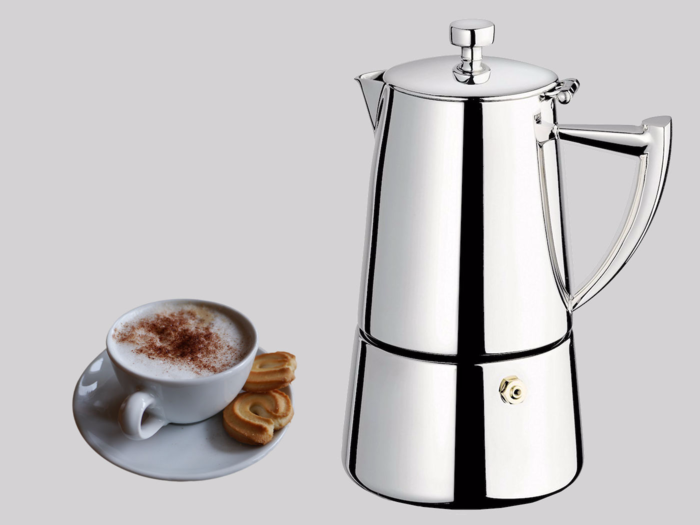
If Bialetti's Moka Express is too old-fashioned and quaint for you, you'll love the slick modern look of the Cuisinox Roma Stainless Steel Stovetop Espresso Maker. It's a high-end, fancy moka pot that's not made out of aluminum. You will pay a premium for it — it's nearly five times more than the Bialetti — but it has a 25-year warranty and top-notch reviews.
Cuisinox used stainless steel to make its stovetop espresso maker, so you know it's going to be durable. The design is more slick, shiny, and curvy than the traditional 8-sided aluminum Bialetti moka pot. Since it doesn't have corners, the insides are easier to clean. However, just like with the other moka pots in this guide, you really don't need to scrub it like crazy.
The process of making coffee in the Roma is the same, too. You simply fill the base up to the water line, spoon moka ground coffee into the funnel, and twist the top closed securely over the grounds and water.
Put a gas burner on low so the flame doesn't go outside of the pot's base and burn the handle. You can also use it on an electric stove, just be careful to place the handle well away from the heating element.
Using less heat ensures that your coffee doesn't burn, either. A few minutes later, you'll hear the pot begin to gurgle as the steam-pressurized boiling water passes through the grounds and up through the spout of the moka pot to become strong, rich coffee.
You can get the Cuisinox Roma in 4-cup, 6-cup, and 10-cup sizes to suit your needs. The 6-cup model will be best for most users, but bigger families will want the 10-cup machine.
Most reviewers consider the Cuisinox Roma to be the best stainless steel stovetop espresso maker and recommend it right alongside the Bialetti. Coffee Gear at Home, Espresso Perfecto, Little Coffee Place, and Home Grounds all say the Roma is a great machine for making strong coffee at home.
Reviews on Amazon are incredibly positive, too. One reviewer expressed "unreserved admiration" for the moka pot and even pitted it against high-end espresso machines. Although it's not made in Italy like the Bialetti, the Cuisinox Roma is very high quality and reviewers on Amazon praise the build quality and durability.
Pros: Stainless steel design, comes in multiple sizes, easy to clean, affordable compared to high-end machines, it works on gas or electric stoves, and it has a 25-year warranty
Cons: Expensive
The best affordable stainless steel option
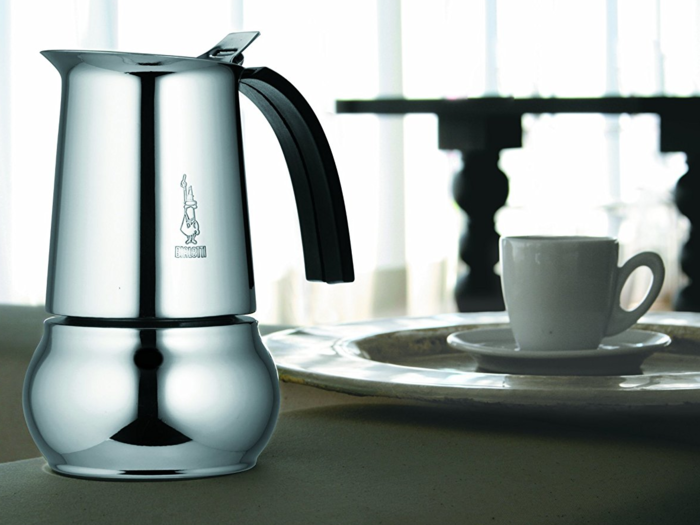
If you want a stainless steel stovetop espresso maker but you're not looking to spend $100+ on one, Bialetti's Kitty Espresso Coffee Maker is the answer.
This stovetop espresso maker is made from 18/10 stainless steel, making it more durable and very attractive to look at. The Kitty looks elegant and classy next to our top pick, the angular Moka Express. It also has a nice wide handle that's easy to grip when you need to serve the espresso.
The Kitty works on gas, electric, and ceramic stovetops, so it should work in most kitchens. You can get it in several different sizes, but we recommend the one that brews 6 cups of espresso or about 12 fluid ounces of coffee.
As with any stovetop espresso machine, you need to follow the instructions precisely to get a good brew. Never overfill the water chamber and always make sure that you use only coffee grounds in the built-in filter.
Most people who bought the Bialetti Kitty gave it positive reviews on Amazon. Negative reviews mention defective units and poor brewing, though some of those bad stories may be down to a faulty technique. The Kitty comes with a two-year warranty in case you run into problems.
Pros: Stainless steel build, durable, attractive design, great handle, affordable, makes great coffee
Cons: It's pricier than the standard aluminum Bialetti Moka Express
The best for espresso shots
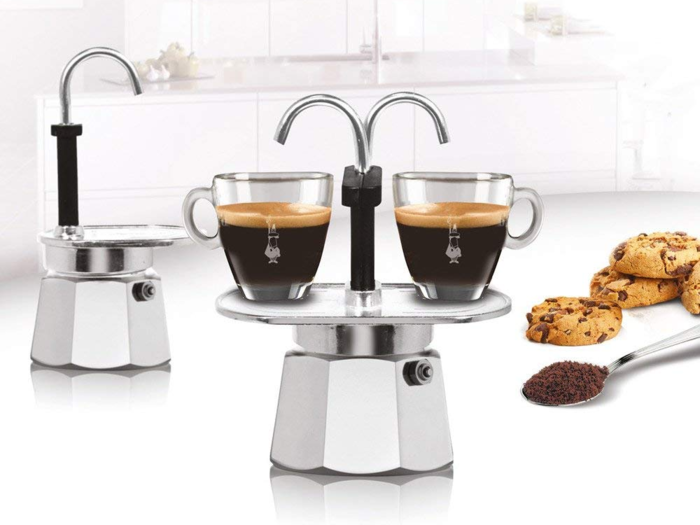
Bialetti's Mini Express Espresso Maker isn't for everyone, but for those seeking a café-quality espresso shot rich with crema could do no better at this price or anywhere south of about $200. I'll concede that reviews have been mixed for this model, but I've had a wonderful experience with it.
Granted, using it requires a little finesse. You want to make sure that your grounds are fine enough for these devices to build up a little pressure. Too often people complain that they don't get a result anywhere near espresso when they're either using the wrong beans or not grinding them finely enough for such a desired outcome.
Also, as always with espresso, use a light roast to achieve a thicker, creamier shot. I also find that the Mini Express produces a shot far quicker than any other stovetop device I've used. Otherwise, it's similar to Bialetti's standard moka pots.
The Mini Express comes in two models: a single-spout and a double. The double can, on occasion, produce uneven shots, but try to get your grounds as even as possible in the basin and it should work out well more often than not. — Owen Burke
Pros: Fast, rich shots
Cons: Requires some finesse
Read our full review of the Mini Express.
The best-looking stovetop espresso maker
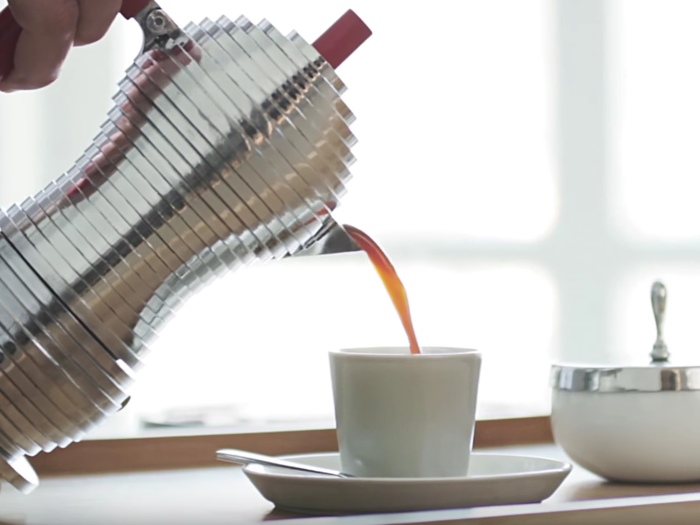
If Bialetti's Moka Express is the everyman stovetop espresso maker, Alessi's Pulcina is the high-brow moka pot for artsy types. Alessi's espresso makers are literally works of art that live in MoMA and other design museums around the world.
Alessi has been designing radically different products since 1921, and its moka pots are well known. The Pulcina was designed by espresso maker Illy and Michele De Lucchi, a famous Italian designer who has worked for Olivetti, Compaq Computers, Philips, Siemens, and Vitra over the course of his long career.
According to Alessi, the Pulcina has a special boiler design that stops filtering the coffee at the "right moment and thus eliminates the 'eruption phase' - the final filtering stage that can generate a burnt aftertaste – thus enhancing its full-bodied and rounded aroma" of your coffee. The pot also has a 'V' shaped spout, which is supposed to be "reminiscent of a baby chick's beak."
The name Pulcina (baby chick) comes from the beak-like spout and the curvy chick-like shape inside of the machine. It also refers to the fact that De Lucchi designed it in the chicken coop where his studio is set up.
Esoteric design talk aside, Alessi is a trusted brand for stovetop espresso makers, and the Pulcina is a great option. Reviews on Amazon are few, but mostly positive. It works just like other stovetop espresso makers, so you put water in the base and coffee grounds in the filter. However, the Pulcina doesn't work on induction stovetops, so you'll need a gas stove if you buy this stovetop espresso maker.
The Pulcina comes in two sizes: 3-cup and 6-cup models with your choice of a red or black handle. The 6-cup one will be best for most people.
Pros: Cool design by Michele De Lucchi, fun color options for the handle, multiple sizes, and it makes great coffee
Cons: Expensive and it doesn't work on induction stoves, wildly different pricing based on colors (see below)
The best electric espresso maker (no stovetop needed)
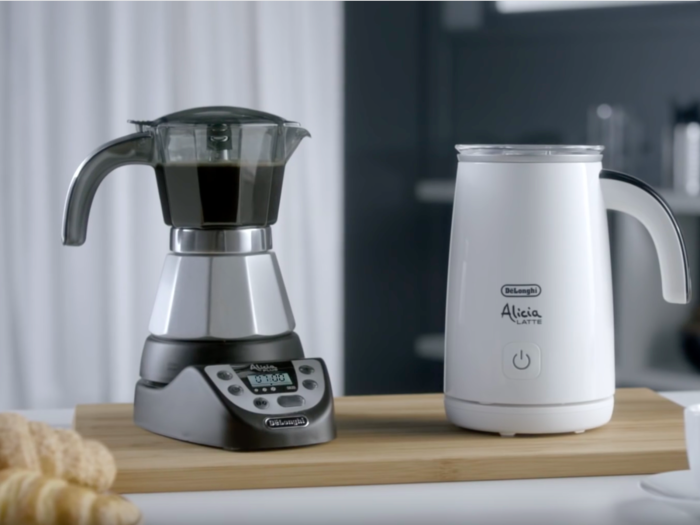
If you want to have a moka pot in an apartment, dorm room, or office without a stove, you'll need an electric one like the DeLonghi Alicia Electric Moka Espresso Maker. It's a modern take on Bialetti's age-old design that combines the tried and true moka pot technique with an electric heating element.
You can make 3 to 6 cups of espresso with it and watch the clear container at the top fill with coffee as it brews. It has an automatic shut-off function that prevents burned coffee and dangerous overflows. The DeLonghi Alicia will even keep your espresso warm for 30 minutes after it's brewed in case you can't drink it fast enough or you like to have two cups before you head out the door.
You can also take the pot off the heating base to take your espresso to the table if you prefer. The base has an on/off switch that lights up when the pot is heating up. You follow the same process of putting water in the base and coffee grounds in the filter before you screw on the top part and pop the pot on the electric heating base.
The moka pot part looks exactly like a traditional Bialetti, the boiler is made out of aluminum, and the entire pot is BPA-free. Even though the top is clear plastic, most reviewers don't seem to mind it. A few reviewers did note that the plastic leaves a taste to the coffee, so beware.
Overall, reviewers on Amazon love how fuss-free and easy to use the DeLonghi Alicia Electric Moka Espresso Maker is and most chose it over a Bialetti because it won't boil over when you're not looking. It's a nice safety feature for families with your children or just busy adult households. The price is also great and comparable to some Bialetti moka pots (if they're not on sale).
Pros: Great for people who don't have a stove, electric heater is easy to use, decent price, it makes good coffee, and it keeps your coffee warm longer
Cons: It may not last as long as a Bialetti
Everything you need to know about stovetop espresso machines
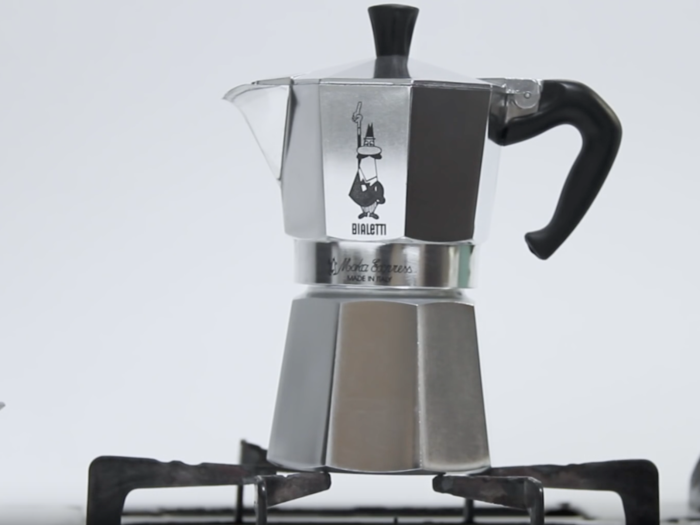
Moka pot vs. fancy espresso machine
Although moka pots don't technically make espresso — because they use lower pressures of 1 to 2 bar and real espresso machines use 9 bar of pressure — the coffee you get is very rich and strong. Some machines will even produce a bit of crema just like high-end espresso machines. If you're using this to make cappuccinos or lattes at home, you'll be more than satisfied, but if you want shots of thick, creamy espresso, you need a real espresso machine.
How many cups do you need?
Most moka pots come in a few different sizes: 1-cup, 3-cup, 6-cup, 9/10-cup, and 12-cup. Keep in mind that the cups in question are small espresso shots — not full cups of coffee as Americans think of them. The 6-cup size is best for couples or people who want to drink two normal cups of coffee with milk on top. The 9/10/12-cup machines are good for families or when you have guests over. I personally own both a 6-cup and a 12-cup Bialetti Moka Express.
Will it work with a gas or electric stove?
Some stovetop espresso makers only work on gas stoves, while others can handle either gas or electric stovetops. We've noted which of our picks work with both kinds of stoves.
Aluminum vs. Stainless steel
Stovetop espresso makers come in either aluminum or stainless steel varieties. Stainless steel models are more fancy, durable, and typically easier to clean. Aluminum machines are typically just as good, provided you buy one from real Italian companies like Bialetti and Alessi. If you buy a cheap aluminum one for $5 at a kitchen store, you may not get the same quality coffee out of it. That's why we recommend you stick to our top pick, the Bialetti Moka Express.
Care and maintenance
It's easy to keep your stovetop espresso maker in good working order. All you have to do is rinse it out after each use and make sure all the ground are out of the filter. No soap or scrubbing is needed. The best moka pots are the ones that have been loved well and the ones that have aged.
Moka pots can last years — decades, even — so long as you don't burn the handle or otherwise harm it. The only thing you'll need to replace periodically is the rubber gasket and filter that prevent the grounds from infiltrating your coffee.
Check out our other great coffee gear guides

We've included top picks for all of these different types of coffee makers. We've tested the majority of our top picks and heavily researched those we have yet to use to bring you the best of all coffee makers.
-
Best drip coffee maker: Bonavita BV1900TS Drip Coffee Maker
-
Best coffee maker under $40: Mr. Coffee BVMC-SJX33GT Machine
-
Best coffee maker under $50: Hamilton Beach 12-Cup Coffee Maker
-
Best coffee maker and grinder: Cuisinart Burr Grind & Brew Automatic
-
Best pour-over coffee: Melitta Ready Set Joe Single Cup Coffee Brewer
-
Best French Press: SterlingPro French Press
-
Best cold brew machine: OXO Good Grips 4-Cup Cold Brew Coffee Maker
-
Best pod coffee machine: Keurig K575 Pod Machine
-
Best stovetop espresso maker: Bialetti 6-Cup Stovetop Espresso Maker
-
Best espresso machine: Breville Barista Express Espresso Machine
Popular Right Now
Popular Keywords
Advertisement